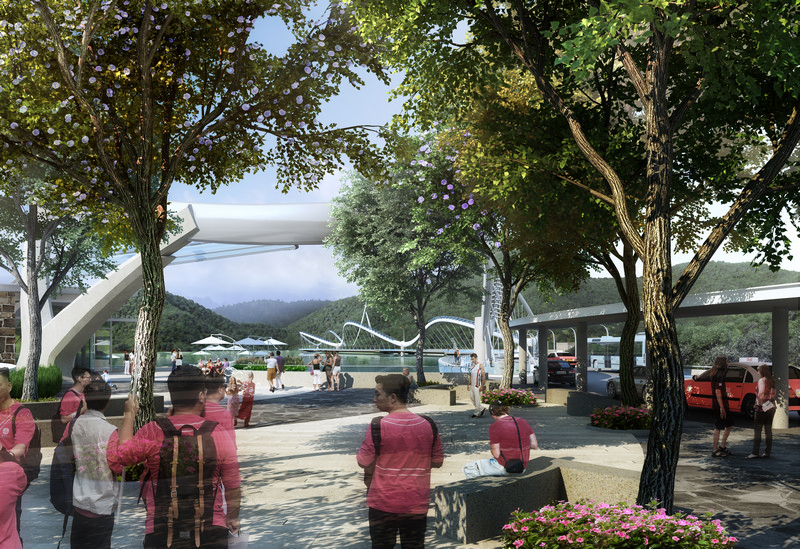Located in Tai Tam Country Park on the south side of Hong Kong Island, Tai Tam Tuk Dam has been serving the community for nearly a century. Integral infrastructure in managing the area’s water resources, is has also carried all of the north and south bound traffic on the east of the island. When completed in 1918, Hong Kong’s population was a mere half million, a fraction of today’s 7 million inhabitants and the heavy traffic it takes to keep the city functioning.

Vision
As well as addressing the growing traffic congestion caused by the dam’s narrow carriageway, Dragon’s Link aims to create a dynamic new piece of “mixed-use” infrastructure serving multiple groups in the community. It will create new connections and offer much needed modern facilities within an existing network of roads and hiking trails to improve the experience of those using Tai Tam Country Park.
Complementing and enhancing the historically significant Tai Tam Tuk Dam, the sensitive design will ensure a minimal impact on the pristine natural landscape and will incorporate the most sustainable lighting technology and environmentally friendly materials. Dragon’s Link is also designed a homage to Hong Kong’s unique cultural identity and will be another attraction for tourists to the city.

History
The Tai Tam Reservoir was a late phase portion of an ambitious water control project initially started in 1872 and spanning to 1936, eventually consisting of 21 different waterworks structures around Tai Tam. Construction on the dam itself commenced in 1912 and was commissioned for service on February 2nd, 1918. The dam and reservoir have provided vital water resources to the Central, Wanchai, Causeway Bay, North Point and Shau Kei Wan districts, allowing urban growth to extend further towards the east of Hong Kong Island in the years following World War I. As it exists today, the dam continues to provide water to Hong Kong and stands as a sturdy monument to the engineering accomplishments of the early 20th Century.
The Tai Tam Waterworks Heritage Trail was established in September 2009. Approximately 5 kilometres in length, it provides hikers access to the 21 structures around the reservoir and is complemented by 10 placards with detailed information about the history and construction of the infrastructure. The Heritage trail is a small piece of the larger “Hong Kong Trail” which extends over 50 kilometres linking the hilly topography of the Island from the Peak to Shek O in eight individual segments.
 Challenges
Challenges
Since the early part of the last century Hong Kong has expanded from a population of roughly 500,000 to over 7 million people. This growth has required significant investment in infrastructure along with land reclamation to accomadate such rapid growth. On the south side of Hong Kong Island the population increases have strained the limited existing network of roads beyond their capacity. Private cars, buses, mini buses and taxis all crowd the narrow roads and now compete for space with an avid cycling community.
The Tai Tam Tuk Dam represents a major bottleneck in this jammed circulatory eco-system due to the existing road being too narrow to accommodate two large vehicles passing one another. This causes frequent traffic jams to occur at both ends of the dam during commuting peak times and on weekends. In addition to this, hikers often find themselves making a dangerous crossing of the dam on foot to navigate between hiking trailheads.
Studies by the SAR Government have determined that traffic controls installed at each end are not a safe or viable solution. Attempting to alter the existing structure (classified as a ‘Grade I Historic Building’) could be unsafe due to its age, in addition to concerns regarding the historic preservation that any modifications would create. Lastly, studies looking to restrict larger vehicles, including tour buses, have been deemed unworkable by the city.
The Dragon’s Link proposes a solution to these problems with a central goal: address the urgent issue of road safety and traffic flow while also providing a new architectural destination and linkage along the Hong Kong Trail.
As part of the “Mixed Use” nature of the design, the proposed Tai Tam Centre located at the southern approach to the new bridge will create a venue for hikers to meet and relax along with a community space to stage events featuring the scenic beauty of the reservoir and possibly to promote eco-tourism.

Design
Conceptually the proposed design takes inspiration from several sources including; the rolling hills of Hong Kong Island, local cultural celebrations featuring the worldrenowned“ Dragon Dance” and as a reference to the linking of the “Dragon’s Back” Section 8 of the Hong Kong Trail. These ideas are transformed into a minimally suppor ted steel arched bridge with the superstructure becoming a spine-like ribbon crossing the water in a playful freeform. Solar photovoltaic (PV) panels create a scale-like skin over the spine of the structure providing eco-friendly power for street lights and architectural lighting of the new bridge. The PV panels will also illuminate the Tai Tam Heritage Trail loop around the reservoir for a new night-time hiking experience.
The alignment of the new bridge will provide views for pedestrians and hikers of the hills and reservoir not possible before given the lack of any walkway. Three scenic viewing points along the way will give people a chance to pause and enjoy the views. On the roadway, vehicles and bicycles will have their own dedicated lanes so conflicts and delays will be greatly diminished making commuters and bikers lives safer and more in harmony. At a time when cities around the world are promoting the benefits of cycling as a way of keeping populations healthy and reducing carbon emissions, Dragon’s Link has the potential contribute to the healthy and sustainable development of Hong Kong over the next 100 years.












